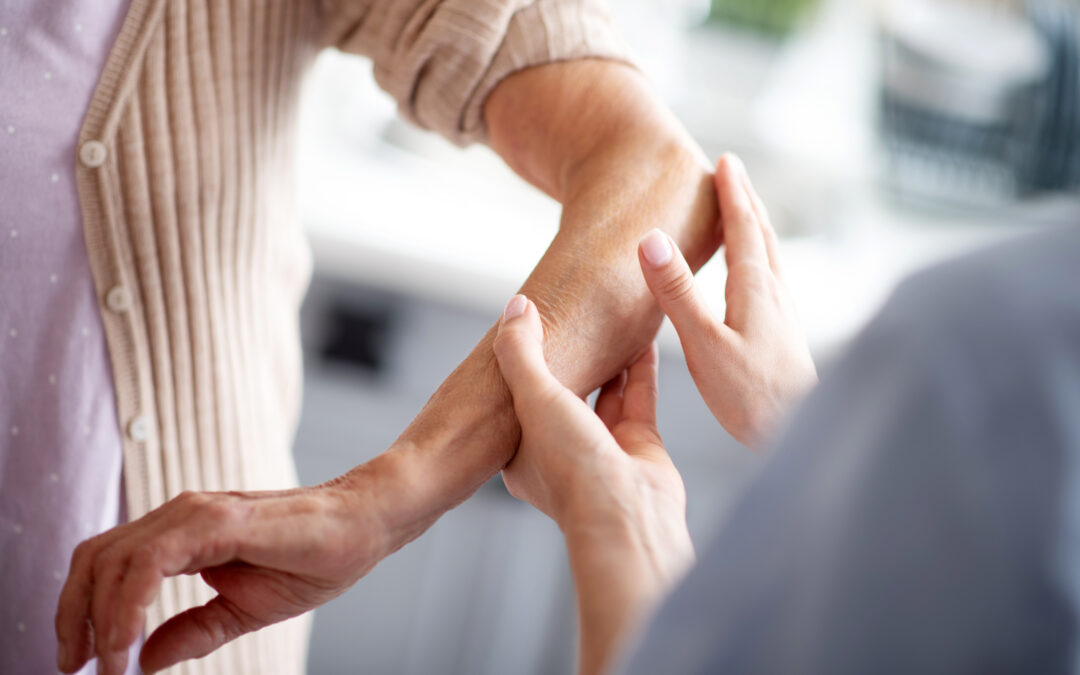Contents
Have you recently just tried to lift some weights or move some boxes, and you felt an ache in your elbow? If you’re experiencing elbow pain while lifting, it can interfere with many of your daily physical activities. If you continue to place stress on your elbow joint while it’s been hurt or affected by a medical condition, you may cause further damage.
Elbow pain when lifting is often brushed off as just a result of possibly lifting more weight than you can handle. But there are many reasons why you may be experiencing pain in your elbow, and they shouldn’t be ignored. The good news is that we’re here to help. Not only will we discuss the potential reasons for your elbow pain, but we’ll also share possible treatment options.
Read on to learn about possible causes for elbow pain when lifting as well as the treatment options that may help, including physical therapy.
5 potential causes for elbow pain when lifting
Your elbow is a hinge joint that is utilized in nearly every arm movement, from opening a door to cleaning your house. When you start to experience elbow pain, it can be difficult to carry out simple physical tasks, especially when the pain also comes with symptoms like a weak grip. But by determining the cause of your elbow pain, you can explore the best treatment options that may help.
Most causes of elbow pain when lifting stem from overuse or injuries from sports.
Here are five potential causes of elbow pain when lifting:
- Tennis elbow — One of the most common causes of elbow pain is lateral epicondylitis, also known as tennis elbow. It refers to inflammation of the tendons on the outside of your elbow, and it annually affects up to 3% of the general adult population. It’s an overuse injury that’s caused by repetitive arm and wrist movements. Along with pain, it can also cause stiffness when trying to extend your arm.
- Fractured elbow — The elbow is a joint that consists of three bones: the humerus, radius and ulna. Trauma to the elbow, such as a fall with an extended arm, can cause one of the bones to break or crack. The symptoms include elbow pain as well as stiffness, swelling and/or bruising.
- Trapped nerves — There are several nerves located in or around your elbow, such as the ulnar, median and radial nerves. When there’s pressure from the surrounding tissue, the nerves can become “pinched” or “trapped.” On top of elbow pain, entrapped nerves can cause numbness and tingling as well as weakness in the hand, wrist or arm.
- Sprain — If you put repeated stress on the ligaments in your elbow, or it sustains an injury, it’s possible for you to sprain the ligament. A sprain means that the ligament has been stretched or torn. The symptoms of an elbow sprain is pain, reduced mobility and joint instability.
- Arthritis — The two most common types of arthritis, or joint inflammation, that can affect the elbow are osteoarthritis and rheumatoid arthritis. Osteoarthritis causes the cartilage between your bones to break down and rub against each other. Rheumatoid arthritis is an autoimmune disease that affects the lining of the elbow joint. Arthritis can cause pain and reduced range of motion.
5 treatments that can help alleviate your elbow pain from lifting
When you’re experiencing elbow pain when lifting, you want to do whatever it takes to alleviate the pain and restore its complete mobility. There are many treatment options that you can explore for elbow pain. Some are self-care options that can be done at home, while others require the assistance of a medical professional.
Here are five treatment options that you can test out for elbow pain:
- Ice — Any sort of pain can benefit from an ice pack, especially after sustaining an injury. Putting ice on your elbow can help numb the area and decrease the blood circulation to alleviate inflammation. Place an ice pack on your elbow for 15 to 20 minutes at a time.
- Medication — If you’re looking for temporary relief from your elbow pain, ask your health care provider about taking nonsteroidal anti-inflammatory drugs, or NSAIDs. You can get over-the-counter pain relief medication such as ibuprofen. For injuries like tennis elbow, you may benefit from NSAID cream or gel that can be applied directly to the area.
- Brace — Reducing the amount of elbow movement throughout your day can help an injured elbow along the healing process by keeping it in place. A brace can provide additional support to alleviate the strain placed on the joint by reducing the amount of pressure placed on the injured tendons.
- Steroids — If your elbow pain is persistent or worsening, your health care provider may recommend a steroid injection. A corticosteroid injection provides temporary, yet immediate, pain relief by reducing inflammation. It’s usually injected alongside an anesthetic.
- Physical therapy — One of the best ways to treat any sort of pain is through physical therapy. When it comes to elbow pain, your physical therapist can help alleviate the pain through manual therapy techniques, such as soft tissue manipulation, which means they use their hands to alleviate the tension in the affected area. They will also walk you through therapeutic exercises to improve the overall function of your elbow.
Lattimore PT provides physical therapy to help treat elbow pain while lifting
Whether you have to lift heavy objects for your job or you’re passionate about weightlifting, elbow pain can hinder your ability to carry out your daily routines. But with the help of pain management and guided exercises from a licensed physical therapist at Lattimore PT, you can ease that ache and restore your elbow’s mobility.
Contact our team today for more information or to schedule an initial appointment.


